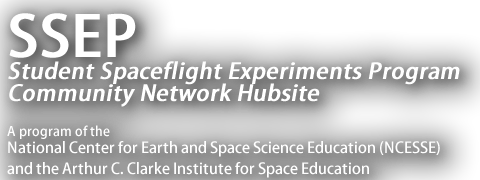Mission 20 is Community’s First SSEP Flight Opportunity: Yellow
Mission 20 is Community’s at Least Second SSEP Flight Opportunity: Green
View SSEP Mission 20 to ISS Communities on a larger map
SSEP Mission 20 to ISS
Experiment Design Competition and Selection of Flight Experiments: Winter/Spring 2025
Flight to ISS: projected launch TBD
The 4 communities profiled below are providing the opportunity for nearly 200 undergraduate students to design and propose real microgravity experiments for flight aboard the International Space Station (ISS) as part of SSEP Mission 20 to ISS – the 22nd SSEP flight opportunity.
Each community conducts a local Flight Experiment Design Competition with student teams designing microgravity experiments across multiple disciplines. Each team submits a formal research proposal, vying for an experiment slot reserved just for their community in a real research mini-laboratory scheduled to fly on the International Space Station. The Mission 20 to ISS community leadership project that across the network of 4 communities a minimum of 190 students will be fully engaged in experiment design, and a minimum of 50 flight experiment proposals from student teams will be received.
Hundreds more grade preK-12 students are being given the opportunity to participate in SSEP Mission 20 to ISS community-wide programming, which includes the design of Mission Patches to fly aboard ISS. Through community engagement activities, together with microgravity experiment design, a total of TBD schools in 4 States are taking part in Mission 20 to ISS.
All four communities are focusing on university undergraduates.
More generally, Mission 20 to ISS is made possible through the involvement of TBD Local Partner institutions, including school districts, corporate foundations, universities, community foundations, and companies, and which are providing both underwriting and material and human resources.
The level of partnership is remarkable, and speaks to what a team of partners at the local, state, and national levels can do together in STEM education.
Visit the SSEP In the News page and the In Our Own Words page to gain an understanding of program impact over all SSEP missions conducted to date.
Quickly Scroll to Individual Communities
Program Scope
Number of participating schools: 3; experiment design and mission patches: Central Alabama Community College, Horseshoe Bend High School; mission patches only: Central High School
Experiment Design Competition
Expected Minimum Number of Students Fully Engaged in Experiment Design: 45 (grades 13-16)
Expected Minimum Number of Student Team Proposals: 15
SSEP Community-wide Engagement Program
Mission Patch Art and Design Competition(s): 1 competition; (grades K-12)
Partner Institutions
Central Alabama Community College
The Plant Good Seed Company, LLC
SSEP Mission Participation
Mission 20 to ISS
SSEP Community Program Directors
Jeremy Carr
A01552161@alabama.edu
Robin Calvert
rcalvert@cacc.edu
Program Scope
Number of participating schools: 7; experiment design only: Morgan Community College; mission patches only: Columbine Elementary School, Green Acres Elementary School, Pioneer Elementary School, Baker Elementary School, Fort Morgan Middle School, Fort Morgan High School
Experiment Design Competition
Expected Minimum Number of Students Fully Engaged in Experiment Design: 30 (grades 13-16)
Expected Minimum Number of Student Team Proposals: 10
SSEP Community-wide Engagement Program
Mission Patch Art and Design Competition(s): 1 competition; (grades K-12)
Partner Institutions
Morgan Community College
SSEP Mission Participation
Mission 20 to ISS
SSEP Community Program Directors
Gavin Fitzgerald
Gavin.Fitzgerald@Morgancc.edu
Chelsea Crandall
Chelsea.Crandall@MorganCC.edu
Program Scope
Number of participating schools: TBD; experiment design and mission patches: TBD; mission patches only: TBD
Experiment Design Competition
Expected Minimum Number of Students Fully Engaged in Experiment Design: 75 (grades 13-16)
Expected Minimum Number of Student Team Proposals: 15
SSEP Community-wide Engagement Program
Mission Patch Art and Design Competition(s): 2 competitions; (grades K-12), (grades 13-16)
Partner Institutions
Florida Institute of Technology
SSEP Mission Participation
Mission 20 to ISS
SSEP Community Program Directors
Andrew Palmer
apalmer@fit.edu
Andy McIlwraith
andy@fit.edu
Program Scope
Number of participating schools: TBD; experiment design and mission patches: TBD; mission patches only: TBD
Experiment Design Competition
Expected Minimum Number of Students Fully Engaged in Experiment Design: 40 (grades 13-16)
Expected Minimum Number of Student Team Proposals: 10
SSEP Community-wide Engagement Program
Mission Patch Art and Design Competition(s): 2 competitions; (grades K-12), (grades 13-16)
Partner Institutions
University of Tennessee
SSEP Mission Participation
Mission 20 to ISS
SSEP Community Program Directors
Kellie Walters
waltersk@utk.edu
Samson Humphrey
shumph21@vols.utk.edu
